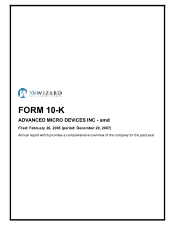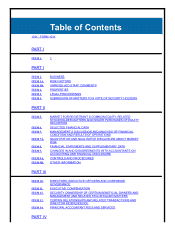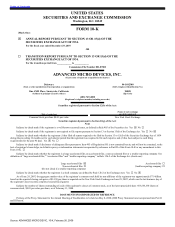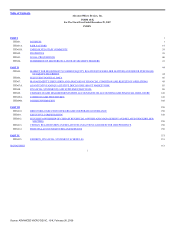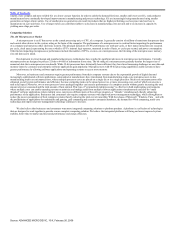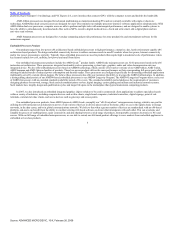AMD 2007 Annual Report Download - page 10
Download and view the complete annual report
Please find page 10 of the 2007 AMD annual report below. You can navigate through the pages in the report by either clicking on the pages listed below, or by using the keyword search tool below to find specific information within the annual report.
Table of Contents
systems and application environments to share a single physical computer, by providing the illusion that each operating system has full control over the
underlying hardware. By enabling different operating systems and applications to run on the same server, virtualization offers the benefit of consolidating
workloads and reducing hardware requirements, which can also reduce power, cooling and system management costs.
In August 2007, we introduced our quad-core AMD Opteron processors. These processors incorporate four processor cores on a single die of silicon, add a
6MB shared L3 cache, and offer features designed to improve performance for virtualized application environments, as well as on floating-point applications
(e.g. mathematic and scientific applications). Quad-core AMD Opteron processors also feature a variety of power-saving technologies, including AMD
CoolCore™ technology, which reduces energy consumption by turning off unused parts of the processor and enhanced AMD Powernow! technology, which
allows each core to vary its clock frequency depending on the performance requirements of the application being supported, and dual dynamic power
management, which provides an independent power supply to the cores and the memory controller. We expect to ship quad-core AMD Opteron processors in
more significant volumes in the first half of 2008.
Our dual-core AMD Opteron processors provide several new features including improved virtualization support through AMD Virtualization ™ technology
and the use of energy efficient DDR2 technology, which is memory technology used for high speed storage of working data. In addition, these processors are
designed to be socket and thermally compatible with quad-core AMD processors.
Notebook Microprocessors. Our microprocessors for notebook PCs consist primarily of AMD Turion ™ 64 X2, AMD Athlon ™ 64 and mobile AMD
Sempron™ processors. We designed our mobile processor products for high-performance, longer battery life and wireless connectivity.
AMD Turion 64 X2 dual-core mobile technology is our most advanced dual-core processor family for notebook PCs. We designed this technology to
enable leading-edge graphics for the more visual experience provided by the Microsoft® Windows Vista ™ operating system, longer battery life, enhanced
security and compatibility with the latest wireless technologies and graphics solutions. In addition, we have designed the process used to manufacture AMD
Turion 64 X2 mobile technology for more thermally efficient processor operation and reduced power consumption.
Desktop Microprocessors. Our microprocessors for desktop PCs consist primarily of the following tiered product brands: AMD Phenom, AMD Athlon
and AMD Sempron processors. All AMD desktop microprocessors are based on AMD64 technology with Direct Connect Architecture.
In November 2007, we introduced the AMD Phenom 9000 series of microprocessors. The AMD Phenom 9000 processors are true quad-core processors
designed for high performance desktop PCs. The true quad-core design enables cores to communicate on the die rather than through a front side bus external to
the processor, thereby reducing a bottleneck inherent in other competing x86 architectures. Additionally, our Direct Connect Architecture allows all four cores to
have optimum access to the integrated memory controller and integrated HyperTransport links, so that performance scales well with the number of cores. This
design also incorporates a shared L3 cache for quicker data access and enables end users to seamlessly upgrade from dual-core systems.
At the same time, we also introduced a desktop platform product codenamed “Spider”. The Spider platform is a combination of the AMD Phenom 9000
microprocessor and advanced chipset and graphics technologies, and is designed for enthusiasts, digital content creators and mainstream users who are seeking
more immersive, visual computing experiences and who require computer systems with superior performance. The AMD Spider platform provides a scalable
high-definition (HD), multi-GPU experience for digital entertainment and advanced multimedia productivity. It incorporates ATI PowerPlay ™, our power
management technology that reduces the power consumption of our graphics processors, Cool’n’Quiet™ 2.0 technology, which reduces power consumption by
reducing the processor’s clock rate and voltage when idle, Microsoft DirectX 10.1 support, a collection of industry graphics technologies designed to deliver
advanced graphics capabilities on Microsoft
5
Source: ADVANCED MICRO DEVIC, 10-K, February 26, 2008

